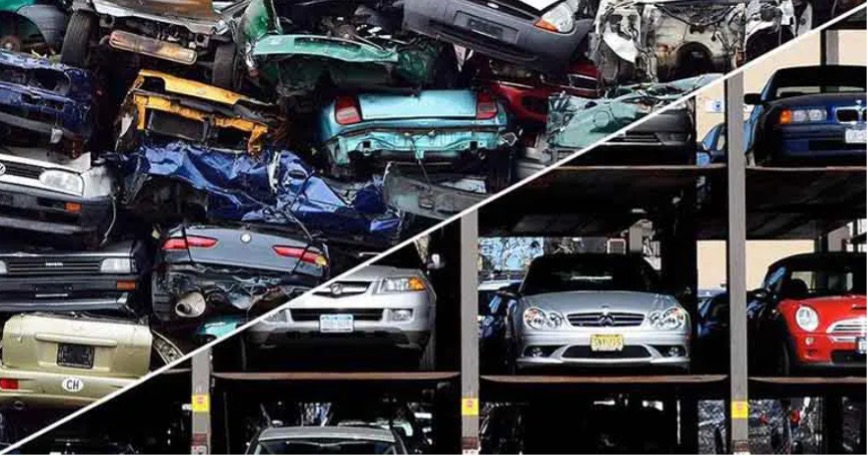The ‘four-wheeled dilemma’: development and environmental aspects of used vehicles

date: 31/05/2022
The history of the automotive industry begins in the early second half of the 19th century. In the 160 years that followed, ‘horseless carriages’ made significant advances. The automotive industry became the symbol of economic growth, prosperity and innovation. But its success became its own worst enemy, as population growth and the desire for individual motorised transport led to more and more vehicles, congestion, air and noise pollution, carbon emissions, dependence on oil and deteriorating road safety. For developing countries, these issues are compounded by illicit trade practices, some of the highest motorisation growth rates and inadequate infrastructure and regulatory frameworks.
To maintain the industry’s viability while mitigating negative impacts related to vehicle manufacture and operation, several initiatives are under way at EU and global level, with key implications for developing countries.
Revision of the End-of-Life Vehicles Directive
The End-of-Life Vehicles directive establishes rules for the dismantling and recycling of end-of-life vehicles (ELV). The original directive entered into force more than 20 years ago. Since then, significant progress has been made in the development of new materials and production processes, which should be reflected in new legislation in line with the Green Deal. The evaluation of the ELV Directive began in March 2021, followed by a public consultation from July to October. An impact assessment is currently under way and the Commission proposal is expected by the end of 2022. The revision is a complex exercise as it is linked to the review of the ‘3R type-approval’ Directive and to other environmental legislation (Circular Economy Action Plan). In addition to the many technical and legal issues related to the internal market, the export of used/ELV vehicles to developing countries has a strong trade and development dimension.
A Dutch report, Used Vehicles Exported to Africa, found strong evidence that many ELVs from the EU are exported to Africa as used vehicles. These vehicles are often far from roadworthy, posing a serious health and environmental hazard. Therefore, the ELV directive also focuses on the issue of so called 'missing vehicles' (according to the impact assessment, 3.5 million vehicles were missing in 2019). The question is how to establish a proper EU-wide registration/deregistration mechanism to prevent such exports, as the EU is the main exporter of used vehicles to Africa. A second option would be to restrict export of used vehicles in general. Recent discussions suggest ideas such as the imposition of a special export tax on used vehicles.
UN initiatives
Given that there are other major exporters (USA, Japan…), the issue of the trade in used vehicles needs to be addressed at a global level. In 2020, UNEP produced a report on the Global Trade in Used Vehicles. According to its findings, there are large regulatory gaps in developing countries related to the quality and safety of imported used vehicles. This enables the EU to export ELVs as used vehicles. For instance, between 2017 and 2018, the Netherlands exported 35 000 vehicles to West Africa, most of them lacking a roadworthiness certificate and between 16 and 20 years old. While still a work-in-progress, preliminary recommendations drawn from the report focus on regulatory reforms in both exporting and importing countries.
In this global context, the EU is also working on a draft resolution text for the UN Environment Assembly addressing the issue of used vehicle exports. The EU also contributes to the UN Road Safety Fund (UNRSF), which, among other things, promotes the use of roadworthy vehicles with an emphasis on periodic technical inspections. These efforts are supported by private sector initiatives, such as the International Vehicle Inspection Committee (CITA) ones, which is working on the establishment of data-supported used vehicles information exchange systems to better monitor technical requirements and conditions of used vehicles in the market.
EU International Partnerships' response
From DG INTPA’s perspective, sustainable and safe mobility must go hand in hand with affordability. In order for the transition to clean mobility to be effective and leave no one behind, gradual reforms are needed that, without being less ambitious in terms of climate change, respond to the needs of the most vulnerable populations. It is also a question of not being naïve – any gap in this market will be rapidly filled by low-cost exports from other regions. Through different national and regional MIPs (for example, within the framework of the SSATP), INTPA supports solutions to mitigate the negative effects of rapid urbanisation by working on more efficient urban transport policy and infrastructure. The aim is to reduce demand and thus the flood of used/ELVs with a high carbon footprint as well as worsening congestion. The deterioration of road safety is closely related, as collisions have enormous negative socio-economic impacts on developing countries as they mainly affect the young and economically active.
